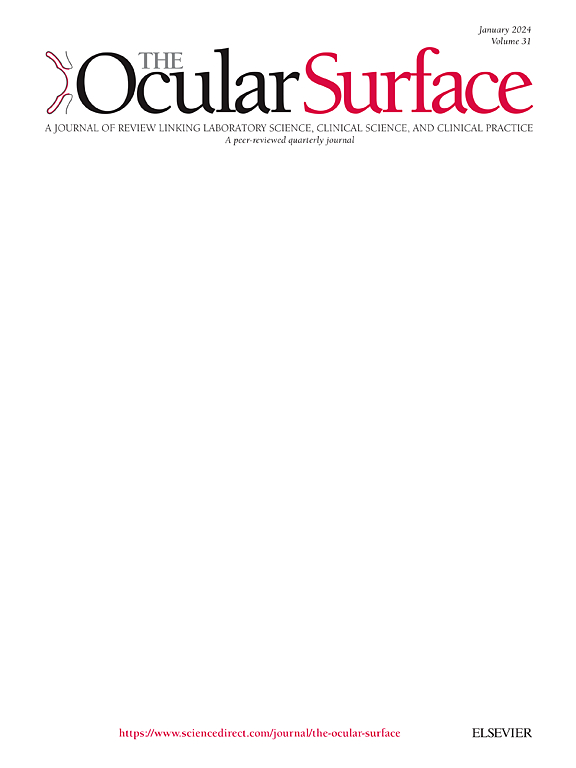移植物抗宿主病的严重角膜表现:三级转诊中心的经验。
IF 5.6
1区 医学
Q1 OPHTHALMOLOGY
引用次数: 0
摘要
目的:移植物抗宿主病(GVHD)是同种异体造血干细胞移植(alloo - hsct)后常见的并发症。GVHD可影响多个器官,包括眼部表现,从干眼综合征到威胁视力的角膜溃疡或穿孔。关于眼移植物抗宿主病的特点和治疗及其与一般预后的关系的信息有限。方法:我们回顾性分析了一家三级眼科中心140例患者的数据,并与国家骨髓移植数据库的系统数据进行了对比。结果:大多数患者采用人工泪液、维生素A软膏、局部抗炎药(主要为环孢素和类固醇滴眼液)、自体血清滴眼液、巩膜隐形眼镜和点状硅胶塞治疗。我们发现移植后中位时间为39个月(四分位数范围(IQR): 16-96)的严重眼部表现比例很高,如角膜溃疡或穿孔(33例,23.6%)。严重和非严重眼部GVHD患者的总生存率没有差异(无严重眼部受累的5年死亡率为8%,严重眼部受累的5年死亡率为13%,生存曲线比较p=0.53)。多因素分析显示,男性患者和HLA不匹配的同种异体造血干细胞移植与严重眼部症状的风险增加独立相关。此外,非甾体抗炎药(NSAID)治疗后并发症发生率较高。结论:因此,GVHD患者应接受密切的眼科监测,由于潜在并发症的严重程度,在任何情况下都不应使用局部眼用非甾体抗炎药治疗。本文章由计算机程序翻译,如有差异,请以英文原文为准。
Severe corneal manifestations of graft-versus-host disease: Experience of a tertiary referral center
Purpose
Graft-versus-host disease (GVHD) is a common complication after allogeneic hematopoietic stem cell transplantation (allo-HSCT). GVHD may affect several organs, including ocular manifestations, ranging from dry eye syndrome to sight-threatening corneal ulceration or perforation. Limited information is available about characteristics and treatments of ocular GVHD and its relation to general prognosis.
Methods
We retrospectively analyzed data from 140 patients from a tertiary ophthalmological center and confronted it with systemic data from a national bone marrow transplantation database.
Results
Most patients were treated with artificial tears, vitamin A ointment, topical anti-inflammatory agents (mostly cyclosporin and steroid drops), autologous serum eye drops, scleral lenses and punctal silicone plugs. We identified a high proportion of severe ocular manifestations, such as corneal ulceration or perforation (33 patients, 23.6 %), occurring with a median of 39 months (interquartile range (IQR): 16–96) after transplantation. Overall survival did not differ in patients with severe to non-severe ocular GVHD (5-year mortality of 8 % without and 13 % with severe ocular involvement, p = 0.53 for survival curves comparisons). Multivariate analysis revealed that male patients and HLA mismatch allo-HSCT were independently associated with an increased risk of severe ocular manifestations. Moreover, a high proportion of complications occurred after non-steroidal anti-inflammatory drug (NSAID) treatments.
Conclusions
Patients with GVHD should therefore undergo close ophthalmological monitoring and they should not, in any case, be treated with local ocular NSAIDs, due to the severity of potential complications.
求助全文
通过发布文献求助,成功后即可免费获取论文全文。
去求助
来源期刊

Ocular Surface
医学-眼科学
CiteScore
11.60
自引率
14.10%
发文量
97
审稿时长
39 days
期刊介绍:
The Ocular Surface, a quarterly, a peer-reviewed journal, is an authoritative resource that integrates and interprets major findings in diverse fields related to the ocular surface, including ophthalmology, optometry, genetics, molecular biology, pharmacology, immunology, infectious disease, and epidemiology. Its critical review articles cover the most current knowledge on medical and surgical management of ocular surface pathology, new understandings of ocular surface physiology, the meaning of recent discoveries on how the ocular surface responds to injury and disease, and updates on drug and device development. The journal also publishes select original research reports and articles describing cutting-edge techniques and technology in the field.
Benefits to authors
We also provide many author benefits, such as free PDFs, a liberal copyright policy, special discounts on Elsevier publications and much more. Please click here for more information on our author services.
Please see our Guide for Authors for information on article submission. If you require any further information or help, please visit our Support Center
 求助内容:
求助内容: 应助结果提醒方式:
应助结果提醒方式:


